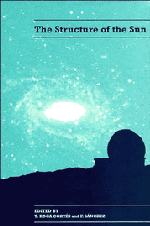Book contents
- Frontmatter
- Contents
- List of participants
- Group photo
- Preface
- TECHNIQUES FOR OBSERVING SOLAR OSCILLATIONS
- TESTING A SOLAR MODEL: THE FORWARD PROBLEM
- TESTING SOLAR MODELS: THE INVERSE PROBLEM
- GLOBAL CHANGES IN THE SUN
- SOLAR INTERIOR AND SOLAR NEUTRINOS
- THE SOLAR MAGNETIC FIELD
- ACTIVITY IN THE SOLAR ATMOSPHERE AS OBSERVED BY YOHKOH
TECHNIQUES FOR OBSERVING SOLAR OSCILLATIONS
Published online by Cambridge University Press: 05 October 2010
- Frontmatter
- Contents
- List of participants
- Group photo
- Preface
- TECHNIQUES FOR OBSERVING SOLAR OSCILLATIONS
- TESTING A SOLAR MODEL: THE FORWARD PROBLEM
- TESTING SOLAR MODELS: THE INVERSE PROBLEM
- GLOBAL CHANGES IN THE SUN
- SOLAR INTERIOR AND SOLAR NEUTRINOS
- THE SOLAR MAGNETIC FIELD
- ACTIVITY IN THE SOLAR ATMOSPHERE AS OBSERVED BY YOHKOH
Summary
ANALYSIS TOOLS AND THE SOLAR NOISE BACKGROUND
When we observe solar oscillations, we are concerned with measuring perturbations on the Sun that are almost periodic in space and time. The periodic waves that interest us are, however, embedded in a background of broadband noise from convection and other solar processes, which tend to obscure and confuse the information we want. Also (and worse), the “almost-periodic” nature of the waves leads to problems in the interpretation of the time series that we measure. Much of the subject of observational helioseismology is thus concerned with ways to minimize these difficulties.
Fourier Transforms and Statistics
A common thread runs through all of the analysis tricks that one plays when looking at solar oscillations data, and indeed through many of the purely instrumental concerns as well: this thread is the Fourier transform. The reason for this commonality is, of course, that we are dealing with (almost) periodic phenomena – either the acoustic-gravity waves themselves, or the light waves that bring us news of them. Since many of the same notions will recur repeatedly, it is worth taking a little time (and boring the cognoscente) to review some of the most useful properties of Fourier transforms and power spectra. In what follows, I shall simply state results and indicate some of the more useful consequences. We shall see below that even when the Big Theorems of Fourier transforms do not apply, (as with Legendre transforms, for instance), analogous things happen, so that the Fourier example is a helpful guide to the kind of problems we may have.
- Type
- Chapter
- Information
- The Structure of the Sun , pp. 1 - 46Publisher: Cambridge University PressPrint publication year: 1996
- 2
- Cited by

